What Is the MLA Style Format?
With various formatting styles for writing a college paper, and switching between formatting styles for your different courses, itΓÇÖs easy to get confused about what the proper MLA style format guidelines you should apply actually are.
The MLA style format is one of a number of documentation and formatting styles that are used in writing scholastic papers. The majority of academic and research fields agree that every quote, reference and borrowed material within a scholarly paper should be credited to the source. However, documentation styles and conventions vary due to the different needs of the wide variety of different scholarly disciplines.
The MLA style format is generally quite a bit simpler, more straightforward and more concise than most of the other documentation styles. A hallmark feature of the MLA style is the usage of the parenthetical citation, which is linked up with an entry on an alphabetical list at the end of the paper. (This list of references is called the “Works Cited” page.)
“MLA” stands for the Modern Language Association of America. This is a long-standing, highly reputable organization in existence since 1883. The MLA style format is primarily used within the humanities, and in particular for papers on the topics of literature and language arts.
The MLA style has been widely utilized by many schools, universities, academic departments, professors and instructors for the past fifty or more years. MLA guidelines are also used by more than 1,100 scholarly and literary journals, academic newsletters and magazines. The MLA style format is also the favored formatting style used by numerous university and commercial presses. The Modern Language Association of America’s guidelines is implemented all throughout the continent of North America as well as other countries such as Brazil, China, India, Japan, and Taiwan.
The main considerations of formatting a paper in MLA style are as follows:
- Document settings should employ 1-inch margins. The written content should be double-spaced using 12-point type.
- There should be a Page Header on the upper right corner of every page. The Page Header should include the author’s name and the correct page number.
- Include a Title Block on the first page, which should be comprised of the assignment information as well as an informative and creative title.
- The paper should include Citations wherever applicable, crediting the sources used directly in the paper. Each Citation should be placed in the sentence near the idea you are paraphrasing or quoting or at the end of the sentence, with no comma between the author and page number. Also, the punctuation following (comma or period) belongs outside of the closing parentheses.
- The paper should include a Works Cited list at the end, sorted alphabetically by author. (If the author is not known, sort by publisher, or if necessary, by title.) Each listing should include the author (or other identifier) with the last name, comma, then first name followed by a period. List the title in quotes, period. The publisher, publication city and year should follow the title.
- Optionally include a Bibliography page after the Works Cited list. Format the Bibliography like the Works Cited list — alphabetically (as opposed to in the order of items cited.) The Bibliography should include ALL works used to create the paper, even if not cited directly in the paper.
Following the MLA style can feel tedious at times. Fortunately, our formatting software is available. This is a great option for those who want to streamline the paper-writing process and be able to rest assured that they are formatting their papers correctly.
David Plaut is the founder of Reference Point Software (RPS). RPS offers a complete suite of easy-to-use formatting template products featuring MLA and APA style templates, freeing up time to focus on substance while ensuring formatting accuracy. For more information, log onto http://www.referencepointsoftware.com/ or write to:
info @ referencepointsoftware.com
Reference Point Software is not associated with, endorsed by, or affiliated with the American Psychological Association (APA) or with the Modern Language Association (MLA).
